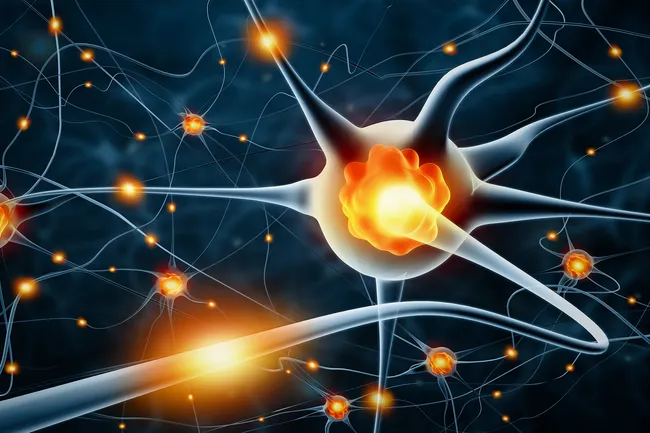August 31, 2019 /
MS: Strangest Symptoms From Head to Toe
 Extreme fatigue, clumsiness, weird prickly sensations, sluggish thinking, wonky vision — these are classic and common first symptoms of multiple sclerosis, or MS. But the expected stops here. Damage to the central nervous system, aka your brain and spinal cord, is what causes these symptoms. That’s a wide range of functions that affect many different people. So it can show up in some strange and varied ways.
Extreme fatigue, clumsiness, weird prickly sensations, sluggish thinking, wonky vision — these are classic and common first symptoms of multiple sclerosis, or MS. But the expected stops here. Damage to the central nervous system, aka your brain and spinal cord, is what causes these symptoms. That’s a wide range of functions that affect many different people. So it can show up in some strange and varied ways.
Trapped in a Bear Hug
 Extreme fatigue, clumsiness, weird prickly sensations, sluggish thinking, wonky vision — these are classic and common first symptoms of multiple sclerosis, or MS. But the expected stops here. Damage to the central nervous system, aka your brain and spinal cord, is what causes these symptoms. That’s a wide range of functions that affect many different people. So it can show up in some strange and varied ways.
Extreme fatigue, clumsiness, weird prickly sensations, sluggish thinking, wonky vision — these are classic and common first symptoms of multiple sclerosis, or MS. But the expected stops here. Damage to the central nervous system, aka your brain and spinal cord, is what causes these symptoms. That’s a wide range of functions that affect many different people. So it can show up in some strange and varied ways.Trapped in a Bear Hug
It’s not a warm and cozy kind of hug. Called banding, this MS symptom feels like something’s squeezing you firmly about the chest and won’t let go. It can strike anywhere between your waist and neck, or just on one side. You might have pain or breathlessness. It happens when damage from the disease blocks or garbles the messages from your nerves. Spasms in the muscles between your ribs trigger the tightness. It often passes on its own.
It can strike anywhere between your waist and neck, or just on one side. You might have pain or breathlessness. It happens when damage from the disease blocks or garbles the messages from your nerves. Spasms in the muscles between your ribs trigger the tightness. It often passes on its own.
 It can strike anywhere between your waist and neck, or just on one side. You might have pain or breathlessness. It happens when damage from the disease blocks or garbles the messages from your nerves. Spasms in the muscles between your ribs trigger the tightness. It often passes on its own.
It can strike anywhere between your waist and neck, or just on one side. You might have pain or breathlessness. It happens when damage from the disease blocks or garbles the messages from your nerves. Spasms in the muscles between your ribs trigger the tightness. It often passes on its own.Out-of-Control Laughing or Sobbing
Pseudobulbar affect, also called PBA or emotional incontinence, prompts random outbursts of tears or laughter that have nothing to do with how you feel.  Nerve damage in the part of your brain that controls emotions can cause your responses to get all mixed up. You might worry about it happening when you’re in public, or in a serious setting. The FDA has approved a drug to treat PBA. Antidepressants can help, too.
Nerve damage in the part of your brain that controls emotions can cause your responses to get all mixed up. You might worry about it happening when you’re in public, or in a serious setting. The FDA has approved a drug to treat PBA. Antidepressants can help, too.
 Nerve damage in the part of your brain that controls emotions can cause your responses to get all mixed up. You might worry about it happening when you’re in public, or in a serious setting. The FDA has approved a drug to treat PBA. Antidepressants can help, too.
Nerve damage in the part of your brain that controls emotions can cause your responses to get all mixed up. You might worry about it happening when you’re in public, or in a serious setting. The FDA has approved a drug to treat PBA. Antidepressants can help, too.
Shocking Face Flashes
Nerve damage can trigger trigeminal neuralgia, a burning, stabbing, or shock-like pain in your cheek or jaw. It might fade fast or linger for a few minutes. Though rare, it can be a first symptom of MS. You might feel it come on as a tingle, numbness, or ache on one side of your face, like dental pain. Anticonvulsant meds such as carbamazepine, lamotrigine (Lamictal), or oxcarbazepine (Oxteller XR, Trileptal) can help.
An Itch You Can’t Scratch
It’s the itch that isn’t. A sudden, intense tingle crops up out of the blue, anywhere on your body. But there’s no skin irritation or allergy to scratch or apply rash cream to. This kind of itch doesn’t stem from your skin. Dysesthetic itching is a nerve-related sensation that passes quickly. It’s treatable with meds for epilepsy. Carbamazepine (Carbatrol, Epitol, Equetro, Tegretol, Tegretol-XR), gabapentin (Horizant, Neurontin), and phenytoin (Dilantin, Phenytek) are a few.
Fiery Feet
Dysesthesia is an unpleasant “altered” sensation like burning, prickly pins-and-needles,  numbness, and creepy-crawlies in any part of your body. For example, your feet might suddenly feel scalded, with no heat source — or damage — at all. Your brain gets distorted nerve signals, so it struggles to relate to something it recalls or imagines. Sometimes it comes up with some pretty crazy stuff. You can treat the weird feelings with nerve pain meds.
numbness, and creepy-crawlies in any part of your body. For example, your feet might suddenly feel scalded, with no heat source — or damage — at all. Your brain gets distorted nerve signals, so it struggles to relate to something it recalls or imagines. Sometimes it comes up with some pretty crazy stuff. You can treat the weird feelings with nerve pain meds.
 numbness, and creepy-crawlies in any part of your body. For example, your feet might suddenly feel scalded, with no heat source — or damage — at all. Your brain gets distorted nerve signals, so it struggles to relate to something it recalls or imagines. Sometimes it comes up with some pretty crazy stuff. You can treat the weird feelings with nerve pain meds.
numbness, and creepy-crawlies in any part of your body. For example, your feet might suddenly feel scalded, with no heat source — or damage — at all. Your brain gets distorted nerve signals, so it struggles to relate to something it recalls or imagines. Sometimes it comes up with some pretty crazy stuff. You can treat the weird feelings with nerve pain meds.
More to read:
Swallowing difficulties, Spinal Tingling sensations, Blurred Vision, Optical illusions, Facial Pains, Migraines, Hearing Problems, Vertigo,
Swallowing difficulties, Spinal Tingling sensations, Blurred Vision, Optical illusions, Facial Pains, Migraines, Hearing Problems, Vertigo,
This Article is Provided by: #MSViewsandNews
::::::::::::::::::::::::::::::::::::::::::::::::::::::::::::::::::::::::::::::::::::::::::::::::::::::::::::::::::::::::::::::::::::::::::::::::::::::::::::::::::
Visit our MS Learning Channel on YouTube: http://www.youtube.com/msviewsandnews
Stay informed with MS news and information - Sign-up here
For MS patients, caregivers or clinicians, Care to chat about MS? Join Our online COMMUNITY



